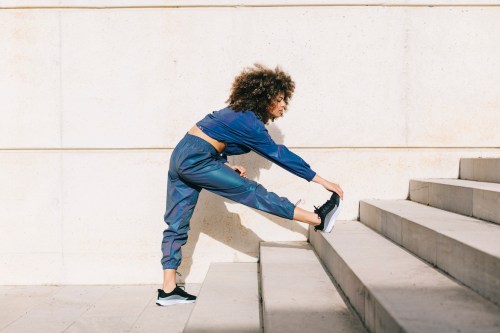Stretching This Often Forgotten Muscle Can Seriously Improve Poor Ankle Mobility
Weak, stiff ankles can be a pain. This 6-step stretching routine can improve poor ankle mobility, according podiatrists.

Quick test: Point your toes up toward your shin. How far can your ankle bend?
Experts in This Article
physical therapist and therapeutic pain specialist
Justin Franson, DPM, is a podiatry specialist based out of Valencia, California.
This movement is called dorsiflexion, and it’s a key part of movement. Having limited ankle dorsiflexion mobility has been linked to common injuries like plantar fasciitis and ankle sprains, and it can also put you at increased injury risk in your knees and hips. It’s also shown to lead to a reduction in performance across a variety of sports and activities.
If you’re looking to improve ankle dorsiflexion, there’s many resources out there that range from muscle stretching to joint mobility to strengthening. Typically, these focus on the superficial calf muscle—the gastrocnemius, which is what you can feel if you put your fingers on the back of your calf—or the ankle joint.
Each of those certainly has a part to play. But, there’s one key piece that’s too often overlooked: the soleus muscle.
“The soleus is the oft forgotten calf muscle,” says physiotherapist Dustin Willis. “It’s a bit out of sight, out of mind because it lies deeper to the gastrocnemius, which you can see and feel easily. Like that muscle, it also feeds into the Achilles tendon.”
Research on the soleus and ankle mobility has shown that gaining more flexibility in this muscle can lead to increases in dorsiflexion as high as nearly four degrees. That’s significant because the average ankle range of motion in that direction is typically around 20 degrees, so we’re talking a change that covers 20 percent of the normal range of motion!
Additionally, there’s emerging research showing the relationship between soleus flexibility and ankle mobility potentially plays a role in athletic performance. A 2022 study found that soleus stretching among soccer players resulted in significantly improved ankle mobility, maximum plantarflexion strength (think strength when pushing off with the foot), and faster running on both straight line and curved sprints.
“A key difference between the gastrocnemius and the soleus,” says podiatrist Justin Franson, “is that unlike the gastrocnemius muscle, the soleus doesn’t cross over the knee joint. This changes the function and role of the two muscles, which needs to be reflected in how to mobilize them.” In other words, the soleus muscle plays a different role than its much hyped-up counterpart (particularly in knee function), and so the most effective way to stretch it is going to look different than your typical calf stretches.
Accordingly, I created this progressive, step-by-step soleus stretching protocol. Give it a try and see how your ankle range of motion increases!
6-step soleus stretching plan for better ankle mobility
This is a six-stage plan with each step being more aggressive than the previous. Begin with stage one and only progress to stage two when you can hold the stretch for three sets of one minute without feeling any tightness. Repeat for stage two, stage three, and so on until you hit stage five. Once you’re at stage five, continue to use that stretch as part of your daily routine to keep the soleus nice and flexible.
1. Seated bent-knee soleus stretch
Sit on the ground with a foam roller (or something of similar size) under your knee. Take your hand and gently pull back on the front of your foot until you feel a stretch.
2. Seated bent-knee soleus stretch with strap
Sit on the ground with a foam roller (or something of similar size) under your knee. Place one end of a looped band (or a belt) around the front of the foot and pull backwards.
3. Standing bent-knee soleus stretch
Leaning into a wall or chair with feet in a staggered position (one foot in front of the other), bend forward at both knees until you feel a stretch.
4. Standing stretch against wall
With feet in a staggered position, place the the ball of your foot up against the wall and slightly bend the knee until you feel a stretch.
5. Standing soleus stretch off step
While standing on a step with a staggered stance (one foot in front of the other), place the back foot in a position where the heel is off the edge of the step. Bend the back knee and lower the heel until you feel a stretch. If you’re worried about your balance, place one hand on a wall or use stairs with a banister.
6. Single leg standing soleus stretch off step
This is very similar to stage five except now you’re lifting the front foot (the one not being stretched). I highly recommend doing this with something to hold onto—both for safety and to get a deeper stretch.
Sign Up for Our Daily Newsletter
Get all the latest in wellness, trends, food, fitness, beauty, and more delivered right to your inbox.
Got it, you've been added to our email list.










